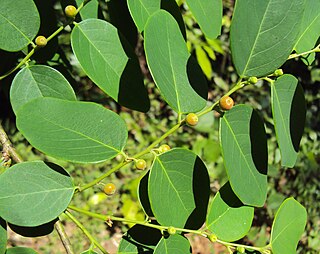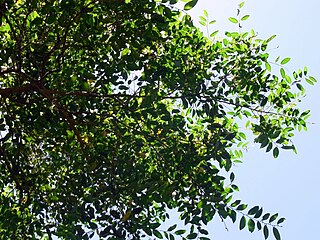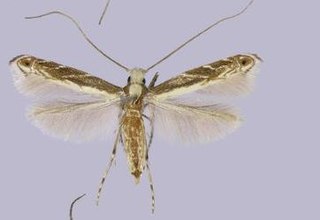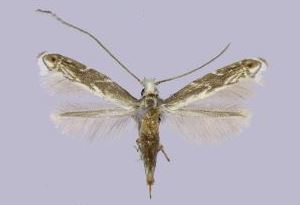
Phyllanthus is the largest genus in the plant family Phyllanthaceae. Estimates of the number of species in this genus vary widely, from 750 to 1200. Phyllanthus has a remarkable diversity of growth forms including annual and perennial herbs, shrubs, climbers, floating aquatics, and pachycaulous succulents. Some have flattened leaflike stems called cladodes. It has a wide variety of floral morphologies and chromosome numbers and has one of the widest range of pollen types of any seed plant genus.

Breynia is a genus in the flowering plant family Phyllanthaceae, first described in 1776. It is native to Southeast Asia, China, Réunion, the Indian Subcontinent, Papuasia and Australia.

Glochidion is a genus of flowering plants, of the family Phyllanthaceae, known as cheese trees or buttonwood in Australia, and leafflower trees in the scientific literature. It comprises about 300 species, distributed from Madagascar to the Pacific Islands. Glochidion species are used as food plants by the larvae of some Lepidoptera species including Aenetus eximia and Endoclita damor. The Nicobarese people have attested to the medicinal properties found in G. calocarpum, saying that its bark and seed are most effective in curing abdominal disorders associated with amoebiasis.

Breynia oblongifolia, commonly known as coffee bush, grows naturally in Australia and New Guinea as shrubs up to 3 m (10 ft) in height. The species produces alternate, distichous, ovate leaves 20–30 mm (0.8–1.2 in) long by 10–20 mm (0.4–0.8 in) wide. Small, green flowers are produced in spring and summer, and these are followed by orange or pink berries about 6 mm (0.24 in) diameter that turn black when fully ripe.

Glochidion ferdinandi, with common names that include cheese tree, is a species of small to medium–sized trees, constituting part of the plant family Phyllanthaceae. They grow naturally across eastern Australia, from south–eastern New South Wales northwards to northern and inland Queensland, in rainforests and humid eucalypt forests. Frugivorous birds such as pigeons, figbirds and parrots consume its fruit. The tree roots and branches are toxic to dogs, causing liver failure and death.
Epicephala spinula is a moth of the family Gracillariidae, one of the most primitive groups of ditrysian "micromoths". Within its family, it belongs to the subfamily Gracillariinae. Even though it was first scientifically studied in 1929, for many decades the specimens of this moth were mistaken for the related Australian species E. colymbetella, and their distinctness was only realized in 1986. It is found on the Marquesas Islands, where it occurs at least on Nuku Hiva, Ua Pou, and Fatu Hiva, and though little-known it is apparently not uncommon. The holotype specimen, a female, is USNM 100839.

Breynia vitis-idaea, the officinal breynia, is a perennial tree-like species of Phyllanthaceae, found from India east to Taiwan and Okinawa and south to Indonesia. It is a shrub or treelet with egg-shaped leaves that can reach up to 3 m tall. It has staminate flowers and spherical, red fruit.

Glochidion zeylanicum var. zeylanicum, known as the umbrella cheese tree, is a plant in the family Phyllanthaceae. It is native to northern and eastern Australia, New Guinea, the Solomon Islands, Vanuatu, Indonesia, Indochina, southern China, Taiwan, Japan, and the Indian subcontinent. It is recognized as a distinct species by some sources, as Glochidion sumatranum and other synonyms. The habitat is rainforest, or rainforest margins in swampy areas, sometimes associated with palms. It may grow to 15 metres tall. The most southerly point of natural distribution is Iluka, New South Wales.

Epicephala vitisidaea is a moth of the family Gracillariidae. It is found in Fujian, China and on the Ryukyu Archipelago.
Epicephala mirivalvata is a moth of the family Gracillariidae. It is found in Fujian and Hainan, China.
Epicephala lativalvaris is a moth of the family Gracillariidae. It is found in China.
Epicephala lanceolaria is a leafflower moth of the family Gracillariidae. The only known host of the larva is Glochidion lanceolarium which is pollinated by the imago.
Epicephala eriocarpa is a moth of the family Gracillariidae. It is found in Fujian, China.

Epicephala bipollenella is a moth of the family Gracillariidae. It is found in Fujian, China and the Ryukyu Archipelago.

Breynia disticha, commonly known as the snowbush, is a plant in the family Phyllanthaceae, first described in 1776. It is native to New Caledonia and Vanuatu in the western Pacific, but naturalized on a wide assortment of other islands around the world, as well as in the U.S. state of Florida.

Epicephala corruptrix is a moth of the family Gracillariidae. It is found on the Ryukyu Archipelago.

Breynia cernua grows naturally in Australia and Malesia as a shrub up to 2 m (7 ft) in height.
Glochidion lanceolarium is a species of leafflower tree in the family Phyllanthaceae. It is native to Cambodia, China, India, Laos, Thailand, and Vietnam. In Mandarin it is known as 艾胶算盘子.

Phyllanthus reticulatus is a plant species described Jean Louis Marie Poiret; it is included in the family Phyllanthaceae.

Glochidion marianum is a species of plant in the family Phyllanthaceae that is endemic to the islands of Guam and the Caroline Islands.













